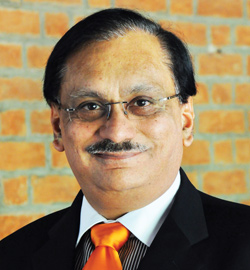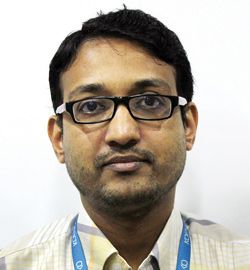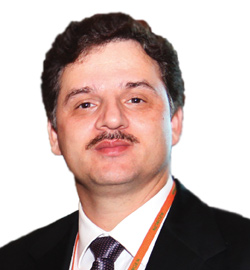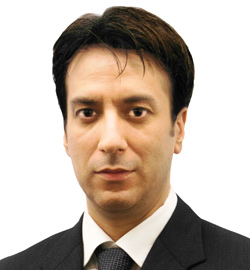
It’s not the first time the world has come across the concept of Internet of Things (IoT), but yes the world was never before more closely associated with the idea of IoT, thanks to the all-pervading impact of the Internet as it enters every aspect of our activities, virtually. With Prime Minister Narendra Modi’s every programme having IoT as an essential element, the story has just started unfolding for India, write Nirmal Anshu Ranjan & Akanki Sharma of Elets News Network (ENN)
The Internet has revolutionised our lives way much beyond we could have ever imagined. Right from ordering food with a single click, calling a cab using an app or buying virtually everything under the sun online, the Internet has come handy.
Apart from our personal lives, the tool has also brought immense benefits to businesses, industries, cities, public sphere and numerous organisations, government or otherwise, in terms of bringing pace and efficiency to the operations.

With the Internet making its way into most aspects of human activity, the gap between physical and digital worlds is on the wane. This connectivity—of physical objects, devices, vehicles, buildings and other items embedded with electronics, software, sensors and network connectivity—enables various objects to collect and exchange data, thereby springing forth the term “Internet of Things” or IoT.
IoT allows objects to be sensed as well as controlled remotely across existing network of infrastructure, thus creating opportunities for more direct interactions between the physical world and computer-based systems that result in greater efficiency, accuracy and financial benefits. These Internet-connected devices interact with each other with negligible or no human intervention and generate intelligent data that is of immense help to both businesses and government, as the data thus generated helps them formulate people-centric strategies with precision.

Moreover, with the government’s announcement to make India a digital nation and create technology-backed smart cities, the concept of IoT has acquired further relevance. With both campaigns having to do a lot with the Internet of Things in particular, IoT is going to be the inthing in the years ahead
Although the concept of IoT has existed for over one-and-a-half decades, it took to the centre stage in very recent times. And now, the whole ecosystem in India alone is expected to reach a market potential of $15 billion by 2020. According to Gartner, globally, there will be nearly 26 billion devices on the Internet of Things by 2020, while experts estimate that IoT will comprise 50 billion connected objects by then.
Moreover, with the government’s announcement to make India a digital nation and create technology-backed smart cities, the concept of IoT has acquired further relevance. With both campaigns having to do a lot with the Internet of Things in particular, IoT is going to be the inthing in the years ahead.
The Digital India programme, which aims at transforming India into digitally-empowered society and knowledge economy, is expected to provide the required impetus for development of the IoT industry ecosystem in the country. IoT, which is very often also defined as interplay of software, telecom and electronic hardware industry, hold tremendous opportunities for many industries.
IoT for Smart Living
One area where a lot of IoT activity is set to happen is smart cities. Be it raising smart buildings, optimal consumption of energy, smart transport, smart parking, various security devices for citizens’ safety, smart mechanism for forecasting disasters or optimising the use of water through sensors – all of these have IoT in common. With 98 cities being identified for development in the first phase, the pace of deployment of IoT is set to be accelerated.
Among the services being planned are smart lights, which means that streetlights can be controlled from a remote location. It can also reduce and increase illumination, have alternate lights on and off facility, and have a smart meter to check on grid use and control electricity usage. Leveraging the existing infrastructure and improve security levels, several cities have already embarked on installation of cameras on streetlights.
Similarly, use of sensors for Solid Waste Management (SWM) and location intelligence would run on IoT-enabled solutions, helping improve the quality of life of citizens. Smartphones, mobile wallets, smart mobility will all be important aspects and play a special role in the new-age cities. Thus, expectations are high, and therefore, a number of companies are also coming up with their IoT solutions for the citizens.
 Founder & CEO eInfochips IMPACTING DAILY LIVES |
Trusted Farming Aide
Globally, this technology has already been implemented in various areas. For instance, there exists a smart irrigation management system, called “WaterBee”, which is intelligent, flexible and easy to use. It collects data regarding the soil content and other environmental factors from a network of wireless sensors to reduce water waste. It is an accurate irrigation scheduling system available at an affordable cost that analyses the data to selectively water different plots of land based on the need. It is used for a variety of commercial applications, including farms, vineyards and golf courses. The advantages include saving of energy, water and money.
Another example is that of “Z-Trap” device, which h Sumitr Tyagi elps prevent damaging of crops by using pheromones. The device is used to trap insects and compiles data on the number of different types of insects in the trap. Including its GPS coordinates, Z-Trap wirelessly transmits the data and also allows farmers to view the types of detected insects.
 Founder & COO SparkTG ENABLING BUSINESSES At Spark TG, we are developing a turnkey Cloud solution for sending, receiving and saving data from sensors. We help businesses to enable their existing devices/equipment/ labs to connect with our cloud platform. We also work on hardware for building IoT solution that connects with Spark TG IoT Cloud. We will soon provide simple APIs so that people will be able to build their own solutions around IoT. SparkTG’s Cloud platform provides communication over protocol such as (MQTT, Websockets, RESTFul, etc.). Remote device can communicate over wifi, zigbee, 2G/3G/4G cellular, Bluetooth etc. to our propagator node connected with Cloud. As an example, a simple android-based phone can work as a propagation node for multiple devices in its Bluetooth range and communicate with Spark TG cloud. |
 CEO, Hitachi Systems Micro Clinic THE NEXT GREAT REVOLUTION IN TECHNOLOGY The Internet of Things is considered to be the next great revolution in technology. Imagine a world where every object we use has a sensor, allowing it to connect to the Internet, so that it can communicate with each other and provides a world that seems like something out of science-fiction. With the Internet of Things fast approaching, that world could become a reality very soon. Experts estimate that the IoT market could be worth as much as $1.7 trillion by 2020. IOT has a growing future in India with the government backing it with full support and big companies are partnering with the government hoping for a better future for all. BRINGING SOCIAL INNOVATION IOT is a big initiative taken by the government, along with Smart Cities and Digital India campaigns. We at Hitachi believe in the concept of Social Innovation for a better tomorrow and are collaborating with all Hitachi group companies and working as one Hitachi to provide state-of-the-art implementation and services for these projects in the time to come. We will be the back-arm for Hitachi in providing IT services such as security and cloud services as security will be a major area to be worried about. Hence, we believe that we are ready to help the government in these projects in whichever way they would require. |
Another domain where IoT has been used is for protecting the woods. Invisible “Track” is a small device that can be covertly placed in trees in protected forest areas to help prevent illegal logging. The devices, which are smaller than a deck of cards, alert authorities when illegally harvested trees pass within range of a mobile network.
 Doing More with IoT
Doing More with IoT
Other areas of possible growth include insurance sector, where some of the insurance companies in India have started experimenting with IoT, primarily in the automobile insurance space and the healthcare sector, which is growing very rapidly and modernising fast.
In a healthcare scenario, patients can now wear devices that monitor vital signs and communicate data to medical practitioners. Healthcare professionals can configure triggers and events that cause appropriate alerts to be sent to the right doctors.
Embedding intelligence by way of real-time data gathering from gateways and devices and consuming them through business processes helps businesses achieve not just cost savings and efficiency, but also generate more revenue patterns. Businesses need to overcome several business- and service related challenges to be able to realise smooth management of varied systems.
 Technical Manager Koenig solutions INDICATING PROMISING FUTURE The collaboration between the Ministry of Urban Development and the Department of Electronics and Information Technology indicates promising future with IoT. The outcome of this alliance can be observed in the form of wide spectrum of programmes to elaborate the awareness and capacities of the IoT in India. Few to name are the upcoming smart cities that use IoT device for traffic management, Indian Railways that uses IoT to keep track of the fuel consumption and the healthcare IoT sensors that continually monitor the health of humans. Many people in India still cannot get the Internet on a consistent basis with reliability problems plaguing many areas. This makes Internet accessibility a formidable challenge in general population. Even when performance of Internet is consistent, bandwidth becomes a serious issue, and since the IoT needs plenty of bandwidth to function properly, this may hinder widespread prevalence of the IoT. India also deals with plenty of challenges regarding its infrastructure. To make the IoT function well, more work first needs to be done to set up support for smart grids, traffic systems, and technologies that can handle increased data demands, like flash storage. Though challenges still remain, the future of the IoT in India is a promising one. With more time and resources, IoT progress could prove to be impressive on a large scale. FROM HYPE TO REALITY Being a leading IT Training organisation, we are planning to launch new programmes that will enable aspirants to learn more about IoT and implement their technical know-how about this revolutionary concept through the hands-on trainings. This is true that IoT is moving from a hype to reality, and we are turning this reality towards the consumers to increase the use of it. Also, it is important that this trend is inculcated in life to consumers, and it is being conceptualised through our IT training company. We are the voice that is making IoT heard through our training and applications. |
 Co-founder & Chief Technology Officer (CTO) SpiderG FIRST PENETRATION WILL BE IN B2B Unlike western markets, we believe that IoT in India will penetrate first in the B2B space. Consumer IoT will take time given the nature of Indian consumer space. B2B will lead in adoption primarily because of the need for companies to automate and gain visibility into the ‘factory-floors’ which traditionally have been seen as blackboxes by management. Logistics are expected to get a real boost from IoT devices. IoT will help increase asset utilisation, along with worker productivity by allowing managers to monitor and control processes on the go. In the long run, IoT devices will help in holistic integration of processes; right from HR to factory floor. This will give immense visibility to management and help them draft effective policies and gain very high profitability. A PROMISING FUTURE Though challenges still remain in consumer acceptance of the IoT, the future of the IoT in India is a promising one. The government is fully backing the effort to develop better infrastructure, companies are coming out with innovative products, and industries understand the benefits that Internet of Things (IOT) provides. With more time and resources, IoT progress could prove to be impressive on a large scale. THE DATA CHALLENGE- Vinay Kumar Parath Director – Commercial & Government Sales, NetApp India & SAARC SpiderG focuses on creating an ecosystem of Web APIs which helps in integrating various B2B processes. So, naturally (industrial) IoT fits into our portfolio of offerings. SpiderG is also planning a first of its kind Cloud platform for (Industrial) IoT devices. This will primarily focus on integrating the software and the hardware infrastructure of any company.  Director – Commercial & Government Sales NetApp India & SAARC THE DATA CHALLENGE Data is the cornerstone of enterprisewide operations at the Centre, state and local government levels. With the government’s push towards ‘Digital India’, special-purpose clouds and applications will emerge to focus specifically on connecting devices and machines. This in turn will generate a huge amount of data that will need to be processed and analysed in real time. The sheer volume of data, and the velocity at which it is generated, altered and consumed, will threaten to overwhelm traditional storage architecture. Adding to this, budgets will never be able to keep pace with data volume, requiring solutions to become more efficient and cost-effective in storing data. An inability to analyse and store data as volume explodes reduces sensor devices to little more than “window dressing” that offers little value to decision makers. In order to manage staggering amounts of structured and unstructured data, the government needs to put in place a robust storage architecture. A tiered storage architecture can help government departments organise sensitivity of information, importance and accessibility to data. |
In addition to all these, it is interesting to note that not just Digital India, but almost every plan unveiled by the Narendra Modi-led government — be it Swachh Bharat, Ganga cleaning — are all intricately connected to IoT. The quickest way for the Ganga Rejuvenation Plan to execute is by installing sensors at the factory discharge points. The Nirbhaya Project, where there is talk of installing GPS devices to be put in public and private vehicles, also depends on IoT mechanism. Similarly, the government plan to link 2.5 lakh village panchayats with broadband connectivity can help roll out village level BPOs, something that is intricately connected with the Internet.
Impediments on Way
With the largescale deployment of networked, intelligent sensor technologies, hundreds of billions of smart sensors and devices will interact with one another without much human intervention, on a Machine-to-Machine (M2M) basis. This will generate an enormous amount of data at an unprecedented scale, providing with information and control of events and objects even in remote physical environments. However, with so much accumulated data, experts believe, it is going to be a major task to keep those safe and secure, away from the hands of unscrupulous elements. So, the issue of security has to be addressed by all means in a futuristic manner.
 Senior Vice President Newgen Software Technologies Ltd HARNESSING THE POWER TARGETING TODAY’S NEEDS Within the last couple of years, IoT has slowly started to penetrate markets as businesses and organisations have started contemplating the value that combining IoT within business process management (BPM) programmes could bring to an organisation. This brings us to analytics, social and mobile capabilities into current processes and the applications that can lead to much desired agility with regard to critical business decisions. Our Intelligent Business Process Suite (iBPS) targets the need of today, combining all the capabilities. The ultimate goal of business process management is to connect people with the right automated systems and processes to measure effectiveness and to keep up to date. BPM adds value to the IoT by connecting smart objects. Data from devices will need to be analysed and actions will need to be taken based on that data. These actions could trigger alerts or invoke corrective processes. |
 Executive Vice President (Global Delivery) Xavient Information Systems A BOOMING MARKET IN INDIA- The convergence of multi-disciplinary facets of the technology ecosystem with IoT (Internet of Things) has been increasing. Internet of things (IoT) is a booming market in India due to the Indian Government’s Digital India programme. In smart homes, the consumer IoT applications that are fueling growth are smart TVs, smart set-top boxes, smart bulbs, smart switches, etc. IoT as a concept is no longer a vision, but a reality. In fact, we have gone beyond IoT into the era of Web of Systems where devices will be able to communicate not only via Internet, but also directly through cloud. The Web of Systems will take the idea of collecting data from physical things and trigger actions in the real world. We are now living in a networked society dominated by connectivity and mobility. 4G has already entered India and with that comes advancement of OTT services. India has begun to experiment with video-on-demand content delivered over the Internet, through platforms like Youtube, Hotstar, Zengatv, to name a few. Sincere endeavours are being made to understand what viewers want, how they want to consume their content, and how much they are willing to pay to view that content. Going OTT isn’t an option anymore, it’s a mandate. The future for content providers holds an act of balancing valuable content and providing that at a fair price, to attract audiences and increase revenue. DIGITISING INDIA At Xavient, we remain committed to build and upgrade ecosystem based on advanced technologies. We are overwhelmed to have been a part of the US chapter of the success story laid out by the implementation of IOT technologies, where the industries and society at large are gaining significantly. India at present is at a cusp of digital revolution and as a committed player, we are open to invest in and partner with organisations to help the government achieve its vision of digitising India. |
Also, while all the exciting work is happening in the Internet of Things domain, another big worry area is interoperability. With multiple standards in play, it will be a while before the country adopts a single IoT standard. Incidentally, this confusion prevails across the globe. The problem compounds as the scale and magnitude of the M2M Internet will be several folds larger than the existing Internet.
 Besides, India as a developing country lacks in universal Internet infrastructure across its length and breadth, like many other countries in the Third World. So, for IoT takes off in the right fashion in India, we have to have a robust Internet connectivity across the country to serve as the launch pad. However, that doesn’t seem a big concern, of late, as the government has already embarked on an optical fibre network project, christened BharatNet, to connect as many as 2.5 lakh village panchayats by the end of 2016.
Besides, India as a developing country lacks in universal Internet infrastructure across its length and breadth, like many other countries in the Third World. So, for IoT takes off in the right fashion in India, we have to have a robust Internet connectivity across the country to serve as the launch pad. However, that doesn’t seem a big concern, of late, as the government has already embarked on an optical fibre network project, christened BharatNet, to connect as many as 2.5 lakh village panchayats by the end of 2016.
10 MAJOR Applications
- Monitoring of parking spaces, vehicles and pedestrian levels in cities
- Intelligent and weather adaptive lighting for streets
- Intelligent roads that send out warnings in the event of traffic jams, accidents, inclement weather
- Monitoring of supply chain processes in the retail industry
- Tracking inventory in a manufacturing plant
- Monitoring water levels in rivers, dams and reservoirs
- Intrusion detection systems in homes and offices
- Monitoring condition of patients in hospitals
- Smart garbage bins that send signal when pickup is needed
- Interactive information kiosks with real time updates
Future Bright
Notwithstanding these and several other challenges, given the Prime Minister’s resolve to make India a digital country, it is obvious that nothing less than IoT will exist in the coming days. IoT being a key feature of his programmes, the domain stakeholders can look forward to brighter times ahead. Moreover, with the Startup India campaign being announced by the Prime Minister recently, it is expected that the demand for Internet of Things to operate these startups will shoot up manifold. So, in the days to come, the firms bringing IoT solutions can look forward to numerous opportunities coming their way.
Be a part of Elets Collaborative Initiatives. Join Us for Upcoming Events and explore business opportunities. Like us on Facebook , connect with us on LinkedIn and follow us on Twitter, Instagram.











